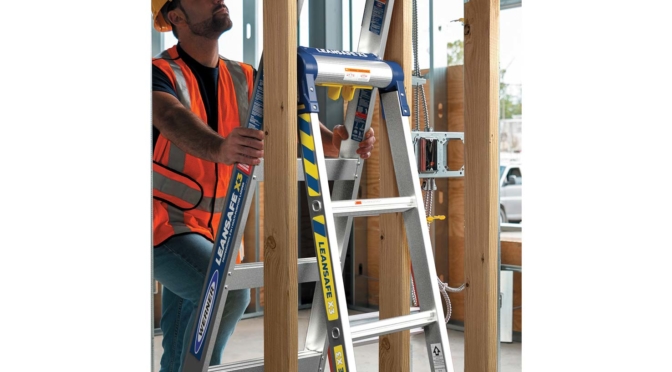Make your jobsite safer and more productive
Selecting the right ladder is an important decision for painting contractors. It’s also an investment in ensuring crew member safety and productivity.
Remember, not all ladders are the same. There are important differences that contractors should consider. The experts at Werner recommend paying attention to four key elements when choosing a ladder: height, duty rating, material, and style.
Height
Height refers to the ladder’s reach requirements. Because the highest permitted standing level on a step ladder is two steps down from the top, the maximum safe reaching height is roughly four feet higher than the step ladder’s height. Thus, a 4-foot step ladder will let painters reach eight feet, while a 16-foot step ladder can reach 20 feet. Further considerations are necessary for extension ladders.
The height of the ladder has obvious considerations—such as being able to paint in high or hard-to-reach spaces—but it also affects team safety.
“Injuries can occur when people are using a ladder that’s not meant for the job it’s being used on,” says Bruce Fischer, vice president of sales at Werner. “Ladder safety is directly tied to having a ladder that satisfies weight, reach and application requirements.”
Duty Rating
A ladder’s duty rating expresses its load capacity. How much weight can it handle? Remember that the weight includes the person using it as well as any materials or tools they’re taking with them.
The Werner Performance System rates ladders from Standard performance (200-225lb load capacity) all the way to Industrial performance (375lb load capacity). The duty rating is a measure of load capacity. Higher duty-rated ladders carry more weight and will also perform better over time in more demanding environments. Contractors use ladders every day and need higher duty-rated ladders that are built to last and handle daily use.
Material
Most commercial ladders fall into one of two categories: aluminum or fiberglass.
Aluminum ladders tend to be preferred by painters because they’re lightweight. They can be easily moved around a jobsite with minimal hassle.
Fiberglass ladders are heavier and very durable. They can better withstand the rigors of construction jobsites. In addition, fiberglass doesn’t conduct electricity, so many contractors prefer it when they’re working in environments with exposed wiring or power lines.
Style
Ladder style concerns the build and purpose of the ladder. Options can range from traditional stepladders to twin-step, extension, and leaning ladders. This aspect is perhaps the biggest variable for contractors. Consider what kinds of projects you cover and in what situations you most often require a ladder.
Contractor needs also drive new products and innovation. In talking to painting contractors, Werner discovered that many contractors wanted a dependable multi-use ladder.
“Contractors would rather load just one ladder into the truck and bring one ladder onto a jobsite than carry multiple ladders,” Fischer says.
In response, Werner developed the LeanSafe X3 ladder, which is a traditional stepladder that can be easily moved into a straight ladder position and is also designed to be used as a leaning ladder. As a result, this 3-in-1 ladder provides efficient climbing solutions for multiple job requirements.
The LeanSafe X3 ladder is part of Sherwin-Williams’ PRO+ductive Solutions initiative, in their PRO+ Program, which is designed to help contractors save time, complete jobs quickly, and save money to generate more profit.
Werner also recently launched the new GlideSafe ladder, in response to contractors looking for a less-strenuous, safer extension ladder model.
“Ladders are heavy, especially when you get into longer-length extension ladders,” Fischer says. “You’re using a rope to raise the extension fly section and then to bring that section back down. On longer length extensions, the fly section can weigh 30 to 40 pounds, and repetitive use is strenuous.
“With this GlideSafe ladder, we installed a spring assist system with cables that significantly reduce the effort needed to raise and lower the fly section. We launched GlideSafe last year, and it’s been very well received by contractors. For somebody who’s using extension ladders every day on the job, the new design is a real game changer.”
Both the GlideSafe and X3 ladders are among 75 Werner unique models stocked by Sherwin-Williams. If a store does not have the specific model their customer needs in stock, Fischer says most stores can have it delivered from their warehouse in a few days. For additional model recommendations, visit the Werner website.
Once you invest in a ladder that’s right for you and your crew, make sure to maintain it and inspect it regularly. Fischer recommends looking over a ladder for any sign of damage prior to every use. Small issues need to be addressed because they can quickly become safety concerns. A ladder with any sign of damage should be taken out of use immediately.
“It’s like any other tool,” Fischer says. “You have to make sure it is safe. You need to pay attention to the details and all the parts. Regular inspection of your ladders for any potential issues is one of the most important aspects of safety.”
Though replacing an old or broken ladder can be frustrating, it can also be an opportunity. Upgrading your ladder can help your team step up their productivity.
“There’s a reason contractors like our ladders,” Fischer says. “They might not be able to identify all the small details of how we build our ladders, but they know that a Werner ladder is as sturdy and comfortable under foot after many years on the job as it was the day they bought it.”

